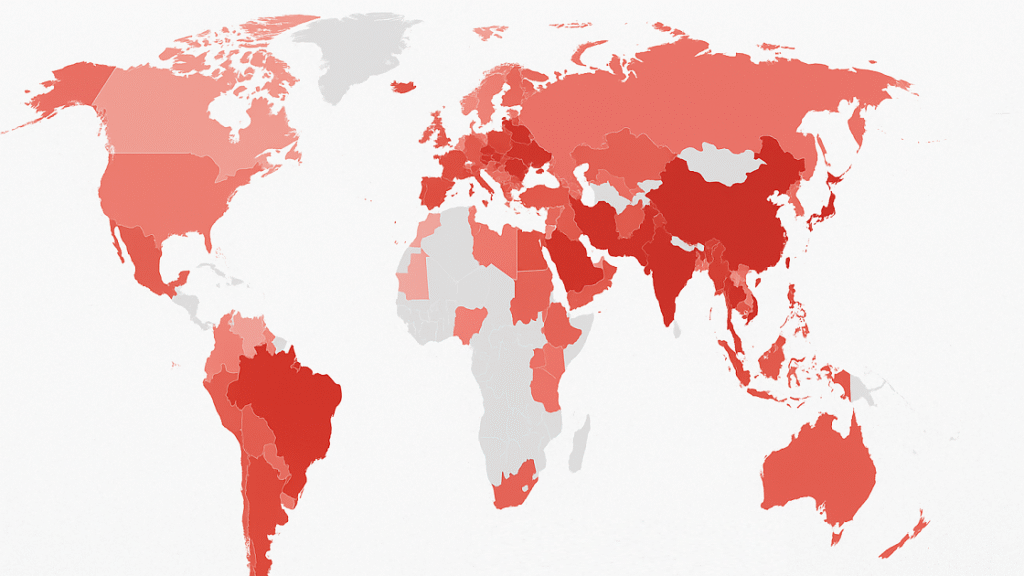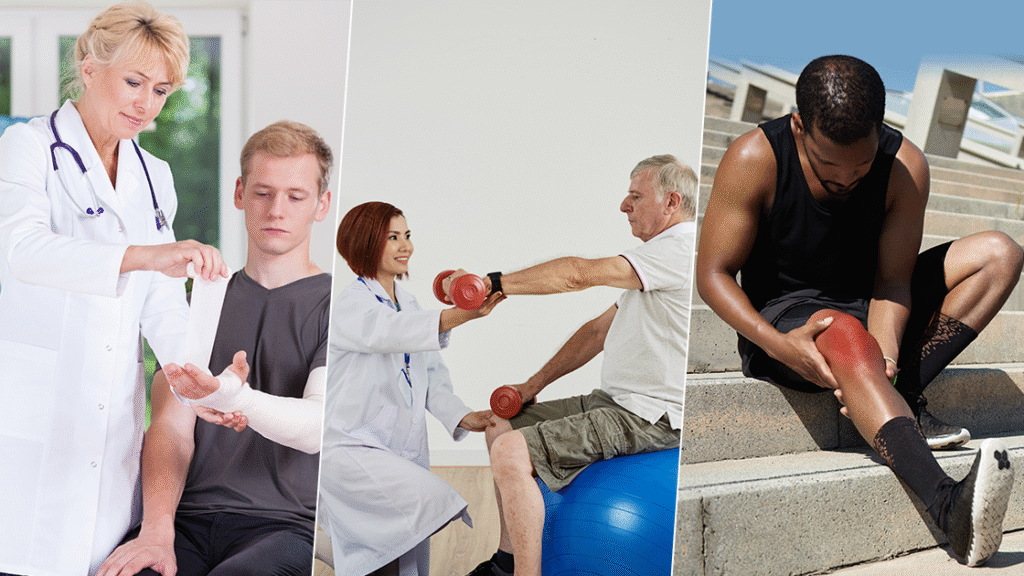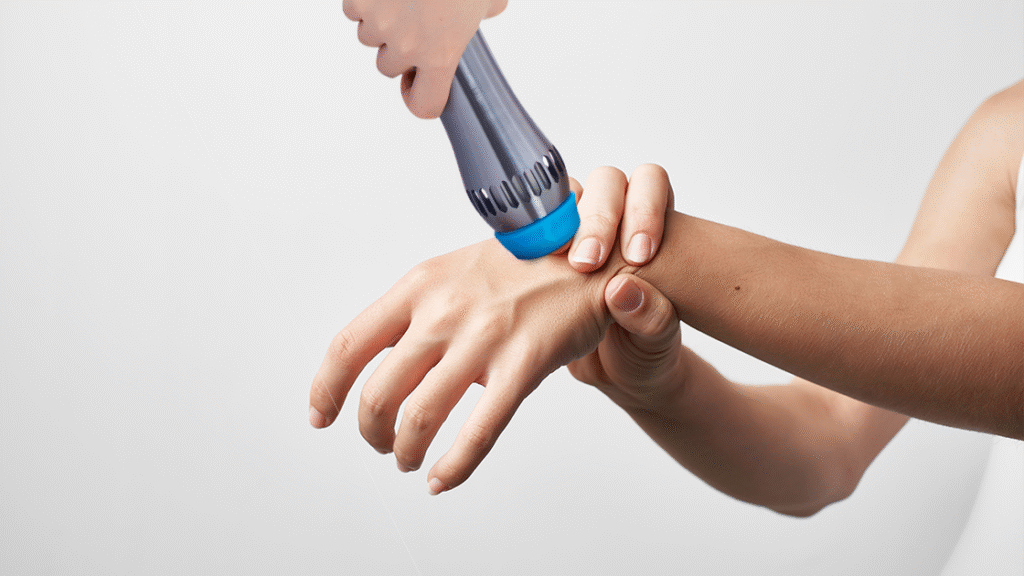Introduction: Chronic Pain and the Search for Relief
Chronic pain affects millions of people worldwide, transforming simple daily activities into overwhelming challenges. As our understanding of pain management evolves, innovative non-invasive therapies are emerging as viable alternatives to traditional treatments. Among these groundbreaking approaches, shockwave therapy stands out as a promising solution that harnesses the power of acoustic waves to stimulate healing and provide lasting pain relief.
The Global Burden of Chronic Pain
Chronic pain represents one of the most significant healthcare challenges of the 21st century, affecting approximately 20% of adults globally according to recent epidemiological studies. This persistent condition, defined as pain lasting longer than three months, extends far beyond physical discomfort to encompass psychological, social, and economic dimensions. The International Association for the Study of Pain (IASP) recognizes chronic pain as a complex neurobiological phenomenon that involves nociceptive, neuropathic, and nociplastic components. Patients experiencing chronic pain often report decreased quality of life, impaired functional capacity, and increased healthcare utilization, creating a substantial burden on both individuals and healthcare systems worldwide.

Limitations of Traditional Pain Management
Conventional pain management approaches, while foundational to modern medicine, present several inherent limitations that leave many patients seeking alternative solutions. Pharmacological interventions, including nonsteroidal anti-inflammatory drugs (NSAIDs), opioids, and anticonvulsants, often provide temporary relief but carry significant risks including gastrointestinal complications, dependency potential, and adverse drug reactions. Invasive procedures such as corticosteroid injections and surgical interventions may offer more targeted relief but involve procedural risks, extended recovery periods, and potential complications. Additionally, many traditional treatments address symptoms rather than underlying pathophysiological mechanisms, resulting in recurring pain cycles and diminished long-term effectiveness for many patients.
Rise of Non-Invasive Therapies in Pain Management
The paradigm shift toward non-invasive pain management reflects growing recognition of the limitations inherent in traditional approaches and patients’ desire for safer, more sustainable treatment options. Evidence-based non-invasive modalities including transcutaneous electrical nerve stimulation (TENS), ultrasound therapy, laser therapy, and manual therapy techniques have gained prominence in contemporary pain management protocols. These approaches prioritize tissue healing, functional restoration, and patient empowerment while minimizing adverse effects and dependency risks. The integration of non-invasive therapies into multimodal pain management strategies represents a holistic approach that addresses both physical and psychosocial aspects of chronic pain, aligning with current best practices in pain medicine.
Introducing Shockwave Therapy: A Modern Option
Extracorporeal shockwave therapy (ESWT) emerges as a cutting-edge non-invasive treatment modality that utilizes high-energy acoustic waves to stimulate cellular regeneration and tissue healing. Originally developed for lithotripsy in urology, shockwave therapy has evolved into a versatile treatment option for various musculoskeletal conditions and chronic pain syndromes. The therapy works by delivering focused or radial acoustic waves to targeted tissues, triggering mechanotransduction processes that promote angiogenesis, collagen synthesis, and cellular repair mechanisms. Clinical evidence supporting shockwave therapy continues to expand, with numerous randomized controlled trials demonstrating its efficacy in treating conditions ranging from plantar fasciitis to chronic tendinopathies, establishing it as a viable alternative to traditional pain management approaches.
Что такое ударно-волновая терапия и как она работает?
Understanding the fundamental principles behind ударно-волновая терапия requires exploring both the technological aspects and the complex biological mechanisms that make this treatment effective. The therapy represents a sophisticated intersection of physics and medicine, where precisely controlled acoustic energy transforms into therapeutic benefit through well-documented physiological processes.
Understanding the Technology
Shockwave therapy devices generate acoustic waves through two primary mechanisms: electrohydraulic or electromagnetic wave generation systems. Electrohydraulic devices utilize spark gap technology to create cavitation bubbles in water, which collapse to produce pressure waves, while electromagnetic systems employ coils to generate focused acoustic energy. These high-energy acoustic waves, characterized by rapid pressure rise times and short durations, penetrate tissues with minimal energy loss. The technology allows for precise targeting of specific anatomical structures through adjustable parameters including energy density, frequency, and pulse duration. Modern shockwave devices feature sophisticated imaging guidance systems and real-time monitoring capabilities, ensuring accurate treatment delivery and optimal therapeutic outcomes while maintaining patient safety protocols.
How Shockwaves Interact with Soft Tissues and Bones
The interaction between shockwaves and biological tissues involves complex biophysical phenomena that initiate therapeutic cascades at the cellular level. When acoustic waves encounter tissue interfaces with different acoustic impedances, they create mechanical stress patterns that influence cellular behavior through mechanotransduction pathways. In soft tissues, shockwaves generate controlled microtrauma that activates inflammatory mediators and growth factors, promoting tissue remodeling and repair processes. Bone tissue responds to shockwave treatment through piezoelectric effects, where mechanical stress generates electrical charges that stimulate osteoblast activity and bone formation. The selective targeting capability of shockwaves allows for therapeutic effects in specific tissue layers while preserving surrounding healthy structures, making it particularly valuable for treating deep-seated pathologies.
Biological Effects
The therapeutic efficacy of shockwave therapy stems from its ability to initiate multiple biological processes simultaneously, creating a synergistic healing environment that addresses both acute and chronic pathological conditions.
Microtrauma and Cellular Regeneration
Controlled microtrauma induced by shockwave therapy paradoxically promotes healing through carefully orchestrated cellular responses. The mechanical stress generated by acoustic waves creates microscopic tissue disruption that triggers the release of pro-inflammatory cytokines, including interleukin-1β and tumor necrosis factor-α, initiating the inflammatory cascade essential for tissue repair. This controlled inflammatory response activates satellite cells, fibroblasts, and other reparative cell populations that migrate to the treatment site. The process stimulates cellular proliferation, differentiation, and matrix synthesis, ultimately leading to tissue regeneration and functional restoration. The precision of shockwave-induced microtrauma allows for therapeutic benefit without causing significant tissue damage, distinguishing it from other forms of mechanical tissue manipulation.
Неоваскуляризация (образование новых кровеносных сосудов)
Shockwave therapy demonstrates remarkable ability to stimulate angiogenesis through upregulation of vascular endothelial growth factor (VEGF) and other pro-angiogenic mediators. The mechanical stimulation provided by acoustic waves activates endothelial nitric oxide synthase (eNOS), promoting vasodilation and enhancing local blood flow. This increased vascular perfusion improves oxygen and nutrient delivery to treated tissues while facilitating the removal of metabolic waste products. The formation of new blood vessels (neovascularization) is particularly beneficial for treating chronic conditions characterized by poor vascularization, such as tendinopathies and non-union fractures. Enhanced vascular supply also accelerates the delivery of immune cells and growth factors to the treatment site, further supporting the healing process.
Stimulating Collagen Production
The mechanical stimulation provided by shockwave therapy significantly influences collagen metabolism through activation of transforming growth factor-β (TGF-β) and other matrix-regulating factors. Acoustic waves stimulate fibroblast proliferation and enhance collagen synthesis, particularly type I collagen, which is essential for tissue strength and structural integrity. The therapy also promotes proper collagen fiber alignment and cross-linking, improving tissue biomechanical properties and functional capacity. This enhanced collagen production is particularly valuable for treating degenerative conditions affecting tendons, ligaments, and other connective tissues. The modulation of collagen metabolism extends beyond simple quantity increases to include qualitative improvements in tissue architecture and mechanical properties, contributing to long-term therapeutic benefits.
Real-World Applications Across Medical Fields
Tendinopathies: Including rotator cuff tendinitis, Achilles tendinitis, and patellar tendinopathy
Bone healing disorders: Such as delayed unions, non-unions, and stress fractures
Joint conditions: Osteoarthritis and joint stiffness management
Chronic wounds: Accelerates healing in pressure ulcers and venous leg ulcers
Diabetic foot ulcers: Enhances tissue regeneration and blood flow for faster recovery
Myocardial ischemia: Investigated for promoting angiogenesis in ischemic heart disease
Cardiac regeneration: Early research shows potential in improving heart function post-myocardial infarction
Injury prevention and recovery: Used to treat overuse injuries and support rapid muscle/tendon repair
Performance optimization: Applied to reduce downtime and inflammation in athletes
Conditions Treated by Shockwave Therapy
The therapeutic applications of shockwave therapy continue to expand as clinical evidence demonstrates its effectiveness across a diverse range of chronic pain conditions. Understanding these applications helps both patients and healthcare providers make informed decisions about incorporating this technology into comprehensive treatment plans.

Musculoskeletal Disorders
Lateral & Medial Epicondylitis (Tennis & Golfer’s Elbow)
Пателлярная тендинопатия (колено прыгуна)
Тендинопатия вращательной манжеты
Nerve-Related Pain
Diabetic Peripheral Neuropathy
Post-Herpetic Neuralgia
Complex Regional Pain Syndrome (CRPS)
Pain Mechanism Modulation
Chronic Back and Neck Pain
Neck Pain and Cervical Disorders
Muscle Relaxation and Anti-Inflammatory Benefits
Joint Pain and Osteoarthritis
Knee, Hip, and Shoulder Osteoarthritis
Cartilage Regeneration Support
Противовоспалительное действие
Fibromyalgia and Myofascial Pain Syndrome
Триггерная точка Deactivation
Muscle Relaxation and Flexibility Improvement
Multimodal Pain Management
Benefits of Shockwave Therapy for Chronic Pain
The advantages of shockwave therapy extend beyond simple pain relief to encompass a comprehensive approach to healing that addresses both immediate symptoms and underlying pathophysiological processes. These benefits make shockwave therapy an attractive option for patients seeking effective, safe, and sustainable pain management solutions.
Неинвазивный и безлекарственный
Shockwave therapy offers a major advantage—it’s completely non-invasive and drug-free. Unlike surgeries that require incisions, anesthesia, and long recovery times, shockwave therapy delivers energy through the skin without breaking tissue or causing downtime. This makes it an ideal option for patients who want to avoid surgical risks or are sensitive to medications. Since it’s drug-free, there’s no risk of side effects, drug interactions, or dependency issues common with chronic pain medications. It also suits those with contraindications to certain pharmaceuticals. Repeated sessions can be safely administered without cumulative risks, allowing physicians to tailor treatments over time. For individuals seeking natural, non-invasive pain relief, shockwave therapy is a modern, science-backed alternative that fits seamlessly into both conservative and advanced pain management plans.
Ускоренное время восстановления
Shockwave therapy significantly speeds up healing by stimulating the body’s natural repair mechanisms at the cellular level. It enhances blood vessel formation (angiogenesis), collagen production, and cell regeneration, creating an ideal environment for fast recovery. Patients often notice improvements in mobility and pain levels within days or weeks—far quicker than the months needed after surgery or prolonged physical therapy. This makes shockwave therapy especially appealing to athletes, workers, and active individuals eager to return to normal life quickly. Shorter recovery periods also help reduce complications like deconditioning or compensatory injuries. By enhancing the body’s own healing response, shockwave therapy minimizes treatment time and costs, while maximizing results. It’s a smart solution for those looking to get back on their feet—fast.
Minimal Side Effects Compared to Surgery or Injections
Shockwave therapy has a strong safety profile, especially when compared to surgery or corticosteroid injections. Side effects are rare, mild, and short-lived—typically limited to slight redness, swelling, or soreness at the treated area, resolving in 24 to 48 hours. Unlike surgery, there’s no risk of infection, bleeding, or nerve damage. Injections, while less invasive, can still lead to complications like tissue atrophy or systemic reactions. Shockwave therapy avoids all of these. For patients with underlying health issues or those unable to tolerate invasive procedures, it offers a safer path to pain relief. Even in higher-risk populations, shockwave can be administered confidently, allowing more aggressive treatment without increasing complications. This safety advantage makes it a go-to option for chronic pain care across age groups and medical backgrounds.
Long-Term Results and Sustained Pain Reduction
Unlike temporary pain solutions, shockwave therapy delivers lasting results by addressing the root causes of chronic pain. It promotes true tissue healing—stimulating regeneration and restoring structural integrity to muscles, tendons, and joints. Clinical studies show improvements in pain and function can persist for months or even years post-treatment. Patients not only feel better—they move better and live more actively. Long-term outcomes mean fewer repeat treatments and a lower burden on healthcare systems. For individuals, this translates to fewer doctor visits, reduced reliance on medications, and a greater quality of life. As a one-time or short-course intervention with prolonged benefits, shockwave therapy stands out for both its therapeutic value and its cost-effectiveness in long-term pain care strategies.
Patient Satisfaction and Real-Life Testimonials
Patients consistently report high satisfaction with shockwave therapy. They highlight not just pain relief, but also improved sleep, movement, and overall quality of life. Many say it gave them results when nothing else worked—restoring hope after years of chronic pain. Testimonials often speak of convenience, minimal disruption to daily routines, and the comfort of avoiding surgery or medications. Active individuals appreciate how quickly they can return to exercise or work. Those who had tried multiple treatments are frequently surprised by shockwave’s effectiveness. The treatment’s hands-on, empowering nature also makes patients feel engaged in their recovery. From chronic back pain to plantar fasciitis, real-world stories showcase how this therapy helps people regain control over their health and lifestyle.
Что ожидать во время сеанса ударно-волновой терапии
A typical shockwave therapy session is quick, non-invasive, and designed for comfort and efficiency. It begins with a thorough assessment, including a review of medical history, symptoms, and physical examination to pinpoint the treatment area. Once identified, a gel is applied to the skin to help the acoustic waves transmit effectively. The provider uses anatomical landmarks and real-time feedback to position the device precisely. During the 15–30 minute session, 1,500 to 4,000 pulses are delivered based on the condition. Most patients describe the sensation as mildly uncomfortable but tolerable, with energy levels adjusted to individual tolerance. After treatment, you may notice slight redness or swelling, which resolves in 24–48 hours. Normal activities can usually resume immediately, though high-impact movement may be limited temporarily. Post-care instructions will be provided. Most patients require 3–5 sessions, typically spaced a week apart, depending on diagnosis and response.

Подходит ли вам ударно-волновая терапия?
Determining candidacy for shockwave therapy requires careful consideration of multiple factors, including the specific condition being treated, patient characteristics, and treatment goals. A thorough evaluation by a qualified healthcare provider is essential to ensure that shockwave therapy is the most appropriate treatment option for each individual patient.
Ideal Candidates and Common Patient Profiles
Chronic pain sufferers, especially those unresponsive to physical therapy, medication, or rest
Patients with soft tissue injuries like plantar fasciitis, tennis elbow, Achilles and patellar tendinopathy
Individuals avoiding surgery or long-term medication use
Athletes and physically active individuals
Patients with good general health and realistic expectations
Those looking for clinically validated, well-studied options for chronic pain
Кому следует избегать ударно-волновой терапии?
Bleeding disorders or anticoagulant use
Беременность
Active infection in treatment area
Malignancy near the treatment zone
Severe cardiovascular disease or implanted cardiac devices
Severe psychiatric or cognitive disorders
When to Consider Shockwave Over Other Modalities
Ударно-волновая терапия - это a strong option when conservative treatments—like physical therapy, rest, or medication—fail to relieve symptoms after 6–12 weeks. It’s ideal for patients aiming to avoid surgery or those with medical conditions that make surgery risky. Individuals with chronic or recurring conditions that briefly responded to other treatments often experience longer-lasting results with shockwave. It’s also recommended for those who’ve had side effects from pain medications or injections. Athletes and active patients needing faster recovery benefit from its tissue-regenerating effects. Shockwave should be part of the discussion when patients want a non-invasive, evidence-based alternative. Ultimately, the decision to use shockwave therapy should involve a shared conversation between patient and provider—balancing expectations, goals, and treatment history.
Risks, Limitations, and Misconceptions
A balanced understanding of shockwave therapy includes recognition of its limitations and potential risks, ensuring that patients and healthcare providers maintain realistic expectations and make informed treatment decisions. While generally safe and well-tolerated, shockwave therapy is not without considerations that require careful attention.
Общие побочные эффекты
Temporary discomfort during treatment
Redness and mild swelling
Skin sensitivity or slight bruising
Temporary numbness or tingling
Rare cases of significant pain or swelling
Extremely low risk of serious adverse events
Minimizing side effects
Misconceptions
“It’s painful or traumatic”: Most patients tolerate it well; discomfort is typically mild and temporary
“It provides instant relief”: Healing is gradual; results often appear over several weeks
“It’s experimental or unproven”: Backed by strong clinical evidence across multiple conditions
“It’s too expensive”: More cost-effective long-term than repeated medications or surgery
“Only for severe cases”: Beneficial for early and chronic stages of musculoskeletal disorders alike
“Replaces all other treatments”: Works best when combined with rehab, physical therapy, or other modalities
When Results May Be Limited or Delayed
Some patients may experience slower or limited results from shockwave therapy due to various influencing factors. Chronic conditions with extensive tissue damage or structural degeneration often respond more gradually. Poor circulation, diabetes, autoimmune diseases, or nutritional deficiencies can delay healing and reduce effectiveness. Patients who continue aggravating activities or fail to follow post-treatment instructions may see diminished benefits. Advanced degenerative conditions may require alternative or combined treatments. In some cases, more than the standard 3–5 sessions are needed to achieve noticeable results. Psychological factors—such as fear of movement or depression—can also impact recovery. Recognizing these challenges helps healthcare providers adjust protocols, set realistic expectations, and offer supportive strategies to improve outcomes.
Recap: Why Shockwave Therapy Stands Out
Shockwave therapy marks a shift in chronic pain management by offering non-invasive, drug-free relief that targets the root causes—not just the symptoms. Its ability to stimulate the body’s natural healing leads to long-lasting improvements in pain and function. Clinical studies support its effectiveness across a wide range of conditions, from tendinopathies to neuropathic and joint pain. Patients value its safety, minimal downtime, and natural healing approach. The therapy can be tailored to individual needs, making it a flexible solution even for those ineligible for surgery or medications. As evidence and applications continue to grow, shockwave therapy is becoming an essential part of modern, patient-centered care. For those who have exhausted conventional options, it offers real potential for meaningful, lasting relief.
Ссылки
- Насколько эффективна ударно-волновая терапия?
- Ударно-волновая терапия для облегчения боли в спине
- Ударно-волновая терапия - мягкое решение проблемы боли в колене
- Ударно-волновая терапия для поддержки поясничного отдела спины, которая работает
- Эффективность и безопасность экстракорпоральной ударно-волновой терапии при ортопедических заболеваниях: систематический обзор исследований, включенных в базу данных PEDro
Effectiveness and safety of extracorporeal shock wave treatment for low back pain:a systematic review and meta-analysis of RCTs
